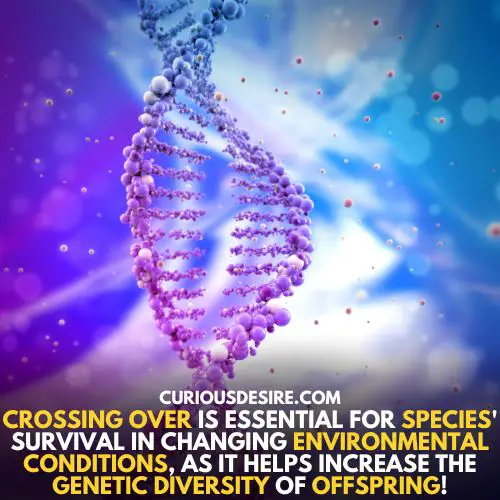Crossing over is a fundamental process of genetics and is essential for producing genetic diversity. It helps to create new combinations of genes, which can then be selected by natural selection or artificial selection, ultimately leading to the evolution of new species.
But why is crossing over important? In this article, we explore 15 reasons why crossing over is important.
15 Benefits of Crossing Over in Meiosis
Crossing over is a key part of the meiotic process. It allows the exchange of genetic material between homologous chromosomes, resulting in the creation of new combinations of genes that are passed on to offspring. This greatly increases the amount of genetic diversity among offspring, increasing their chances for survival and evolution.
Here are 15 reasons why is crossing over important and plays an integral role in the development of life on Earth.
1. It creates new gene combinations
Crossing over helps to mix and match genetic material, creating novel combinations of genes that could produce beneficial characteristics. It is essential for the formation of new species and can also create variations of existing species.
By mixing up genetic material, crossing over creates offspring that differ from both parents, leading to genetic diversity. This diversity can be beneficial in allowing organisms to become adapted to their environment, providing a greater chance of survival.
Furthermore, crossing over allows for the selection of desired traits, such as those found in crop plants and domestic animals.

2. Crossing Over reduces the genetic load
Crossing over helps to reduce the number of harmful recessive alleles inherited from both parents. By exchanging genetic material with another chromosome, crossing over can help to reduce the amount of undesirable genetic information being passed down to offspring.
Recessive alleles are usually masked by dominant alleles, meaning they can remain hidden in the genome and only be passed on if both parents carry them. Through crossing over, these recessive alleles can
3. Crossing Over enhances genetic diversity
Crossing over creates a greater level of genetic diversity than random mating alone, allowing species to become more adaptable.
Crossing over is an essential process that helps to create genetic diversity, allowing species to adapt and thrive in changing environments. Through the crossing over of chromosomes, different combinations of genes can be created, which could facilitate a species’ evolution and survival.
This process also helps to increase the chances of gaining beneficial traits since more alleles are available for selection.
4. Crossing Over increases the accuracy of meiosis
By exchanging genetic material between chromosomes, crossing over helps to reduce errors that can occur during meiosis.

This is because the exchange of genetic material creates new combinations of genes, which are more likely to form functional proteins or be expressed properly in the organism than if the same combination were obtained through random mutation.
In this way, crossing over ensures accuracy during the meiotic process.
5. It allows for the transfer of beneficial traits
Crossing over can allow advantageous genetic material to be transferred between species, leading to an increase in fitness in the recipient species.
This process is known as gene flow and can be beneficial for both species involved. When genetic material is exchanged between species, it can confer advantages to the recipient species, such as new alleles or adaptations that may help them survive in a changing environment.
In addition, the donor species may also benefit from receiving advantageous alleles that could improve their own fitness.
6. It helps to prevent inbreeding depression
Crossing over helps to ensure that offspring are genetically distinct from their parents, reducing the chances of inbreeding and inbreeding depression.
Crossing over is an essential process for the maintenance of genetic diversity and the prevention of the development of harmful recessive traits. It allows for gene flow between species and helps to reduce errors during meiosis, leading to greater accuracy in reproduction.
By exchanging genetic material between chromosomes, crossing over creates novel combinations of genes that could produce beneficial characteristics, increasing the fitness and adaptability of species. It also helps to reduce inbreeding depression, allowing species to remain healthy and viable into the future.
7. It increases the chances of successful reproduction
By increasing genetic diversity, crossing over increases the chances that offspring will possess beneficial traits and be able to reproduce successfully. Crossing over is essential for species’ survival in changing environmental conditions, as it helps increase the genetic diversity of offspring.

Through exchanging genetic material between chromosomes, different combinations of genes can be created that may provide a species with advantageous traits or adaptations needed to survive and thrive in a new environment.
This process also helps to prevent inbreeding depression and reduces the chances of errors during meiosis, ensuring greater accuracy in reproduction. In this way, crossing over helps ensure the survival and success of species in a rapidly changing world.
8. Crossing Over accelerates evolution
Crossing over plays an important part in adaptive radiation, which is when a single species evolves into many different species in a short period of time.
Crossing over is a key process in ensuring that species are able to adapt and survive in changing environments. It increases genetic diversity, allowing for novel combinations of genes that may produce beneficial characteristics or adaptations that can help a species survive or even thrive in a new environment.
By exchanging genetic material between chromosomes, it helps to reduce errors during meiosis and increase the chances of successful reproduction. In this way, crossing over plays a significant role in accelerating evolution and helping species adapt to changing environments.
9. Crossing Over facilitates sexual reproduction
Crossing over is an essential part of sexual reproduction, as it helps to create novel combinations of genetic material in offspring. Through exchanging genetic material between chromosomes, crossing over can create distinct genetic combinations that are not identical to either parent.
This is important for species’ survival in changing environments, as it increases the chances of advantageous traits being passed on and helps to prevent inbreeding depression.
By increasing genetic diversity, crossing over helps species to remain healthy and viable into the future. In this way, it is an important mechanism for facilitating sexual reproduction and ensuring species survival.
10. It improves the accuracy of genetic engineering
The process of crossing over is also used in genetic engineering, as it helps to increase the accuracy and efficiency of gene manipulation.

By swapping genes between chromosomes through the process of crossing over, researchers are able to create novel combinations of genetic material that could lead to beneficial traits or adaptations.
This process is especially useful in the field of genetic engineering, where researchers utilize crossing over as a way to increase the accuracy and efficiency of gene manipulation.
11. Crossing Over helps to maintain genetic stability
Crossing over is essential to maintaining a stable genome and reducing the chances of mutations or errors during meiosis. By exchanging genetic material between chromosomes, crossing over helps to reduce inbreeding depression and decreases the chances that any deleterious mutations will be passed on to future generations.
It also increases the accuracy of reproduction by creating novel combinations of genetic material that can help a species adapt and survive in changing environments.
In this way, crossing over helps to ensure the stability of populations by helping them to remain healthy and viable into the future. It is an essential process for maintaining genetic stability and ensuring species’ survival in rapidly changing environments.
12. Crossing Over Prevents inbreeding
Crossing over prevents the occurrence of inbreeding by introducing new genetic combinations. It is an important part of genetic recombination, which helps to introduce new genetic combinations into a population and reduce homozygosity. This reduces the amount of homozygosity, which can lead to an increase in unfavourable traits and recessive diseases due to a lack of genetic variation within a population.
Unfavourable traits can be caused by the expression of recessive genes, and crossing over helps to prevent this. With a greater variety of genetic combinations, there is an increased chance of producing more favourable traits. This means that the population can survive in its environment better due to improved adaptation capabilities.
13. Crossing Over Improves adaptive potential
Crossing over also improves the adaptive potential of a species by introducing new combinations of traits. This allows the species to better adapt to its environment, which can increase its chances of survival.
By introducing new alleles or combinations of alleles, crossing over helps organisms respond to changes in their environment more quickly and successfully.
14. It Improves reproductive success
By producing more viable offspring, crossing over increases the reproductive success of a species.
It increases the genetic variation within a population, which allows for more diverse features and traits to be introduced. This enhances the adaptability of a species to its environment and increases its chance of survival in different habitats.
15. Prevents disease
Crossing over can help reduce the occurrence of genetic diseases by introducing new combinations of alleles. This helps to reduce homozygosity within a population and allows more favourable traits to be expressed, which can help prevent the emergence of recessive genetic disorders.
Conclusion
In conclusion, crossing over is an essential process for maintaining species’ health and ensuring their long-term survival on Earth. This process plays a key role in meiosis, gene flow, and evolutionary processes, allowing species to adapt to changing environmental conditions.
It helps to increase genetic diversity, create new combinations of genes, reduce the chances of inbreeding depression, and facilitate sexual reproduction. Without crossing over, species would be unable to survive in ever-changing environments.
By understanding the importance of crossing over, we can better appreciate the complexity and beauty of the natural world around us.